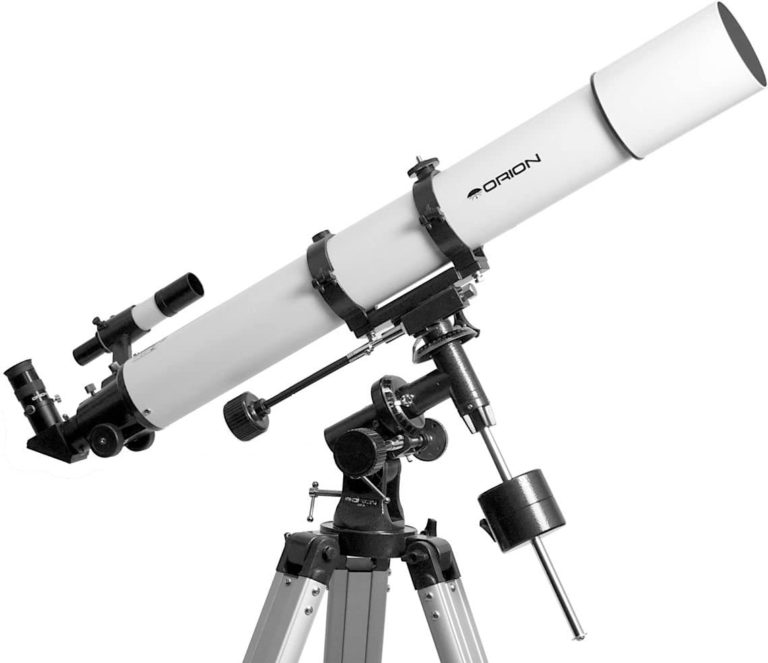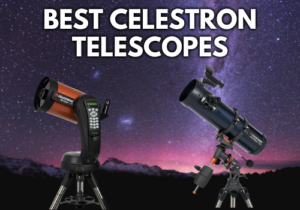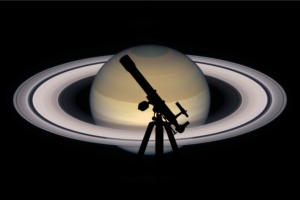Best Telescope Under $300 In 2025; Reviews
Disclosure: This post contains affiliate links and I may earn a small commission (at no extra cost to you) if you click through and make a purchase. Thanks in advance – I really appreciate it!
Here in this “Best Telescope Under 300” article we’ve rounded up 6 of the best telescopes of various types, specifications, and budget perfectly suited to be used by someone looking to take their astronomy game to the next level. Below, you’ll find in-depth reviews of each, as well as an elaborate buying guide to help you pick out the one that suits you the most.
COMPARISON TABLE
| Image | Title | Best For | Features | Price | Buy |
|---|---|---|---|---|---|
Top Top
Top
Top
Top Top
Top
Top
Top | Celestron - AstroMaster 130EQ | Best For Beginners | Type: Reflector, Aperture: 130 mm(5.1″), Focal length: 650mm, Focal Ratio: f/5 | See on Amazon | |
 Top
Top
Top
Top
Top
Top | Orion 8944 SkyQuest XT6 | Best Dobsonian | Type: Reflector, Aperture: 150mm (5.9″), Focal length: 1200mm, Focal Ratio: f/8 | See on Amazon | |
 Top
Top
Top
Top
Top
Top | Orion 10015 StarBlast 4.5 Astro Reflector | Best For Planets | Type: Newtonian Reflector, Aperture: 115mm (4.53″), Focal length: 450mm, Focal Ratio: f/4 | See on Amazon | |
 Top
Top
Top
Top
Top
Top | Celestron - AstroMaster 114EQ | Best Reflector | Type: Newtonian reflector, Aperture: 114mm (4.49″), Focal length: 1000mm, Focal Ratio: f/9 | See on Amazon | |
 Top
Top
Top
Top
Top
Top | Gskyer Telescope | Best For iPhone Astrophotography | Aperture:90mm(3.5”), Focal length: 600mm, Focal Ratio: f/6.7 | See on Amazon | |
 Top
Top
Top
Top
Top
Top | Orion 09007 SpaceProbe 130ST | Best For DSOs | Type: Reflector, Aperture: 130 mm(5.1″), Focal length: 650mm, Focal Ratio: f/5 | See on Amazon |
Product prices and availability are accurate as of the date/time indicated and are subject to change. Any price and availability information displayed on [relevant Amazon Site(s), as applicable] at the time of purchase will apply to the purchase of this product.
Prices pulled from the Amazon Product Advertising API on:
Best Telescope Under $300
With so many models with so many features available today, it can be a tedious task to find the best telescope in the 300 dollar price range. We have analyzed the main features ( aperture, focal length, ratio, portability, affordability etc.) that make a good telescope for intermediates that you can use to enjoy the night sky and fulfill your love for astronomy.
Best Telescope For Beginners
Celestron AstroMaster 130EQ
- Type: Reflector
- Aperture: 130 mm(5.1″)
- Focal length: 650mm
- Focal Ratio: f/5
- Mount: Equatorial
- Eyepiece: 20mm, 10mm
- Magnification: 32.5x, 65x
- Weight: 28.0 lbs.(12.7 kg)
- Our Rating: 9.2/10
Prices pulled from the Amazon Product Advertising API on:
Product prices and availability are accurate as of the date/time indicated and are subject to change. Any price and availability information displayed on [relevant Amazon Site(s), as applicable] at the time of purchase will apply to the purchase of this product.
The telescope is fitted with a 1.25 rack-and-pinion focuser and two eyepieces to get new users started – a 10mm that yields 65x power and a 20mm for a 32.5x magnification.
The 20mm eyepiece integrates an erecting system to correct images horizontally and vertically to allow easy terrestrial use.
The AstroMaster 130EQ also features an unmagnified red-dot finder to help set-up, align and navigate easier.
Celestron’s AstroMaster 130EQ 130mm f/5 Reflector Telescope features a 650mm focal length and an oversized parabolic mirror that produce detailed images of the Moon, clear views of the planets, and the ability to resolve distant objects such as nebulae and galaxies.
The 130EQ comes on a lightweight German equatorial mount that works well enough for the 130 mm f/5 OTA, and it should work okay with a DSLR camera piggybacked on top.
Since it can get quite hard to keep the object in the view because of the Earth’s rotation, there is an upgrade for this mount to help you with that.
It is a simple clock motor which you turn on after you get the object in the view and it will track the object keeping it in the middle of the eyepiece. It’s much easier to stargaze like this rather than twisting the knobs while looking through the eyepiece. The motor is not included but it can be bought separately.
The Celestron’s AstroMaster 130EQ is one of the best entry level telescopes for beginners under 300 dollars as not only is it great for planetary viewing, with the moons of Jupiter and rings of Saturn being star attractions, but being a reflector telescope with a wide aperture, it could be one of the cheapest telescopes on offer that can decently display and photograph deep space objects.
At just 17 lbs total weight and thanks to its compact design, the Celestron AstroMaster 130 EQ is very portable. You can take it literally everywhere with you, unlike heavier and bulkier telescopes for professional use.
Pros:
- Very good optics
- Decently priced telescope
- Suitable for beginners as well as advanced users
- Clear crisp mirrors
Cons:
- Focuser is of limited usability
- No filters included
Best Dobsonian
Orion 8944 SkyQuest XT6
- Type: Reflector
- Aperture: 150mm (5.9″)
- Focal length: 1200mm
- Focal Ratio: f/8
- Eyepiece: 25mm
- Magnification: 21x
- Weight: 20 lbs. (9kg)
- Our Rating: 9.4/10
Prices pulled from the Amazon Product Advertising API on:
Product prices and availability are accurate as of the date/time indicated and are subject to change. Any price and availability information displayed on [relevant Amazon Site(s), as applicable] at the time of purchase will apply to the purchase of this product.
The Orion SkyQuest XT6 Classic Dobsonian telescope is the best dobsonian telescope under 300 as it can open up the night sky for you and your entire family.
With excellent light grasp, point-and-view ease of use, convenient portability, and a low price, the XT6 Classic Dobsonian reflector should be on the top of any beginner’s telescope wish-list.
The primary mirror has a 6-inch (150mm) aperture with a focal length of 1200mm and a focal ratio of f/8. There is no spherical aberration as the primary mirror is parabolic.
The Classic XT6 comes with a single eyepiece – a 25mm Plossl(48x magnification).
The Orion SkyQuest XT6 Classic Dobsonian is built around a 150mm diameter parabolic primary mirror that collects nearly eighty percent more light than a 4.5″ reflector telescope.
The XT6 performs especially well at planetary and lunar observation because of its long focal length of 1200mm and resultant focal ratio of f/8.
When viewing brighter planets such as Mars, Jupiter, and Saturn through the XT6 Classic, you will see them in much sharper detail.
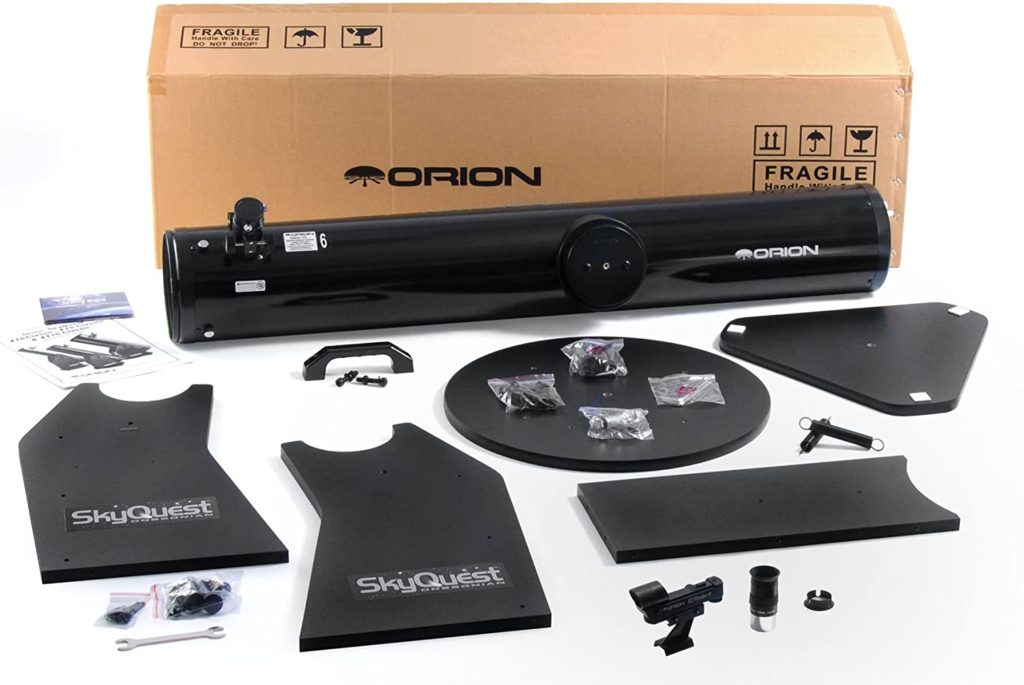
The Dobsonian base is a simplified altazimuth mount also known as a rocker box.
It’s constructed of wood with three basic Teflon pads for azimuth bearings and UHMW polyethylene pads for the altitude bearings. The motions are smooth and the base is very stable which means no vibrations.
The Orion SkyQuest XT6 Classic Dobsonian also includes a quick collimation cap for easy mirror alignment, and dust caps for the reflector telescope tube and focuser.
The EZ Finder II is a battery-powered red dot finder with zero power (no magnification). It helps you locate celestial objects and accurately aim the XT6 in their direction.
Pros:
- Quick and easy setup
- Crisp optics for a gorgeous viewing experience
- Affordable
Cons:
- Not for astrophotography
- Only 1 eyepiece
Related
Best Refractor
Orion 9024 AstroView
- Type:Refractor
- Aperture: 90mm (3.54″)
- Focal length: 910mm
- Focal Ratio: f/10.1
- Mount: Equatorial
- Eyepiece: 20 mm, 4 mm
- Magnification: 36x, 91x
- Weight: 23.7 lbs.(10.75 kg)
- Our Rating: 9.2/10
The Orion AstroView has exceptionally good optics. Its excellent optics, weight and size make it one of the best telescopes under 300 with a 90mm aperture and 910mm focal length.
Views of the planets and Moon through the f/10 AstroView 90 telescope are nothing short of spectacular. When aimed at the Moon, the AstroView 90 yields tack-sharp views of the rocky lunar surface with craters and mountainous regions visible in crisp, high-contrast detail.
On a clear evening, you can expect to see Jupiter’s cloud banding and all four of its major Galilean moons.
Depending on the time of year, the Orion AstroView 90mm EQ Refractor can also provide your whole family with exquisite views of Saturn and its stunning rings, also its largest largest moon known as Titan.
The two eyepieces included are a 25mm and a 10mm one which offer a magnification power of 36x and 91x respectively. The eyepieces are of good quality and the package also contains a 90º mirror star diagonal which means you will see the images with the correct side up.
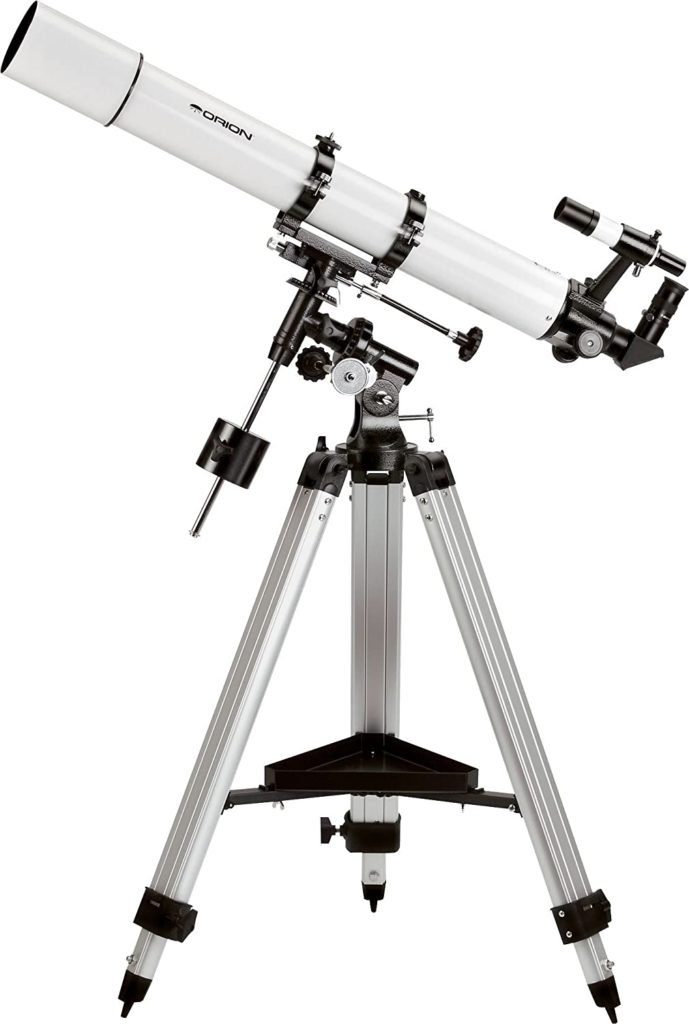
Following a simple alignment procedure, you can use a 6×30 finder scope to accurately aim the AstroView 90mm refractor at objects in the sky like the Moon, bright planets, nebulae and star clusters.
The AstroView 90mm Equatorial Refractor comes with the Orion EQ-2 equatorial mount, which allows for easy manual tracking of celestial objects as they appear to move across the night sky.
All you have to do is occasionally adjust the equatorial mount’s R.A. (Right Ascension) slow-motion cable to keep any object centered in the telescope eyepiece.
The included aluminum tripod is lightweight and features adjustable legs and a tripod accessory tray for a hassle-free viewing session.
The entire AstroView 90 telescope, fully assembled, weighs only 24 pounds, and being a refractor it doesn’t need collimation, so you can pick it up and easily move it around in one piece or keep it fully assembled and ready to use at a moment’s notice.
Pros:
- Great optics
- Spectacular views of the moon and planets
- Quality components
- Equatorial mount that makes it easy to track object as they transit on the night sky
Cons:
- Slight wobble at focus
Best For Viewing Planets & Galaxies
Orion 10015 StarBlast 4.5
- Type: Newtonian Reflector
- Aperture: 115mm (4.53″)
- Focal length: 450mm
- Focal Ratio: f/4
- Mount: Altazimuth
- Eyepiece: 17mm, 6mm
- Magnification: 26x, 75x
- Weight: 13 lbs(5.9 kg)
- Our Rating: 9/10
Prices pulled from the Amazon Product Advertising API on:
Product prices and availability are accurate as of the date/time indicated and are subject to change. Any price and availability information displayed on [relevant Amazon Site(s), as applicable] at the time of purchase will apply to the purchase of this product.
The Orion StarBlast 4.5 (10015) is an excellent choice of telescope for beginners who are eager to begin their astronomical careers, as well as for intermediate astronomers looking for a budget travel telescope, who can utilize its features for the best extraterrestrial viewing.
You don’t have to spend time assembling the Orion 10015 StarBlast 4.5 Astro Reflector, as the telescope arrives pre-built so that anyone can take it out of the box and begin using it right away. It’s a great compact and highly portable budget telescope for beginners and families.
The scope features a substantial 4.5″ aperture and f/4 focal ratio that provides bright, detailed views of solar system targets like the Moon and planets, as well as wide-field celestial objects like nebulas and star clusters.
The telescope’s lens is made of a low thermal expansion borosilicate glass. This means that it is capable of focusing light with increased precision.
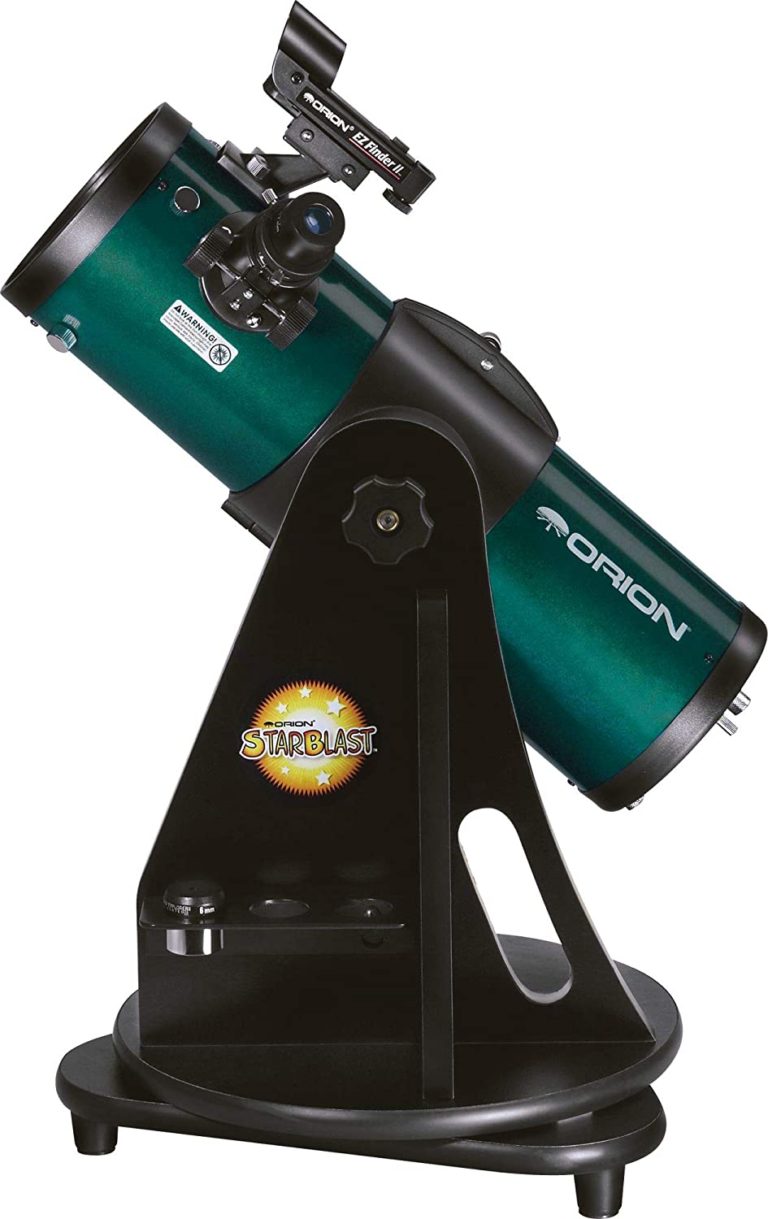
The StarBlast’s included red-dot finder is more than adequate, thanks to its extremely wide field of view.
The model only comes with a tabletop mount, so it really can only be used indoors or outdoors on a picnic table or similar piece of patio furniture.
Its table top design makes it one of the best travel telescopes under 300 dollars. It has a wider footprint than some competing models, which makes it more steady and less prone to being knocked over.
On clear nights, you will be able to view not only the Moon and its craters, but also Jupiter, Saturn, and its beautiful rings.
The scope’s Dobsonian mount means that beginners and new users can point easily. All in all, the Orion Starblast 4.5 will enchant even advanced users with its bright images of the galaxies, nebulas, and star clusters.
Pros:
- Simple to use
- Equipped with EZ Finder for easy aiming
- Includes Starry Night astronomy software
- Features a fast-focal ratio
- Comes pre-assembled
- Two eyepieces along with a dust cover in this telescope
Cons:
- Cannot attach DSLRs
- Collimation process takes a lot of time
Best Reflector
Celestron – AstroMaster 114EQ
- Type: Newtonian reflector
- Aperture: 114mm (4.49″)
- Focal length: 1000mm
- Focal Ratio: f/9
- Mount: Equatorial
- Eyepiece: 20mm, 10mm
- Magnification: 50x, 100x
- Weight: 17 lbs (7.71 kg)
- Our Rating: 8.2/10
Prices pulled from the Amazon Product Advertising API on:
Product prices and availability are accurate as of the date/time indicated and are subject to change. Any price and availability information displayed on [relevant Amazon Site(s), as applicable] at the time of purchase will apply to the purchase of this product.
The Celestron AstroMaster 114 EQ reflector telescope is a great beginner telescope for an adult or a teenager. It’s 4.5” mirror will provide clear and bright images of the Moon, the planets, and dozens of deep-sky objects like the Orion Nebula, the Andromeda Galaxy, the great star cluster in Hercules, and much more.
It features all-glass optical elements, smooth operating steel tripod mountings with manual motion controls, and coated optics for enhanced image brightness and clarity. The quick-release, no-tool dovetail attachment makes setup a breeze. It’s all anchored by a rugged, pre-assembled tripod with 1.25-inch steel tube legs, providing a rigid and stable platform.
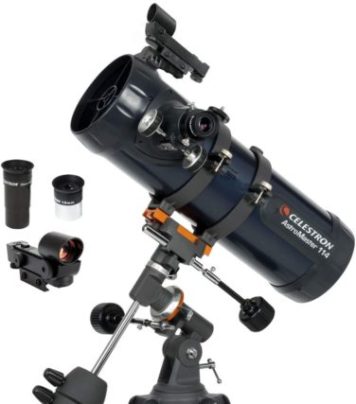
The scope is outfitted with a 1.25 rack-and-pinion focuser and two eyepieces (20mm & 10mm) to get new users started, and an unmagnified red-dot finder to help set-up, align and navigate easier.
The Celestron AstroMaster 114 EQ reflector telescope comes with a 4.5” mirror as its light-gathering source, and with optics that large, an amateur astronomer can see millions of light years into the Universe.
With the telescope, you will also receive a wonderful piece of software with the Celestron AstroMaster 114 EQ reflector telescope.
TheSkyX First Light Edition planetarium software can be loaded on your computer to help assist you with an observing plan. It has a 10,000 object database and enhanced images of celestial objects
Pros:
- Easy to setup and use
- Versatile telescope
- Excellent optics for the price
- Sturdy, retractable tripod
- Portable
Cons:
- Modest focuser
- Not good for astrophotography
Best For Astrophotography
Gskyer AZ90600
- Type: Refractor
- Aperture: 90mm(3.5”)
- Focal length: 600mm
- Focal Ratio: f/6.7
- Mount: Altazimuth Mount
- Eyepiece: 25mm,10mm,5mm
- Magnification: 24x, 60x, 120x
- Weight: 18 lbs. / 8.2 kg
- Our Rating: 9.2/10
Prices pulled from the Amazon Product Advertising API on:
Product prices and availability are accurate as of the date/time indicated and are subject to change. Any price and availability information displayed on [relevant Amazon Site(s), as applicable] at the time of purchase will apply to the purchase of this product.
Gskyer is a German company and is one of the best telescope brands in the world, known to produce high-quality telescopes.
This is a great starter telescope for the explorer who intends to take their telescope with them on their journeys. Hiking, camping, and even moonlit fishing trips will be more fun when you have this telescope along with you.
The Gskyer AZ90600 is one of the best refractor telescope under 300. If you live in the city and you aren’t able to see much of the sky due to light pollution, you’ll want a telescope like this that’s easy to carry with you.
The 90 millimeter aperture is perfect for viewing most of the things you’d want to view, and all of the glass optics are coated to automatically adjust the brightness of the stars to a level safe and comfortable for observation.
Though this is a beginner telescope, you can use it to observe the moon, stars, meteors, and planets. The telescope offers great clarity, allowing you to see the surface of the moon, the rings of Saturn and the moons of Jupiter.
It also comes with a smartphone adapter, which allows you to use the phone as a screen, or as a camera to take great pictures.
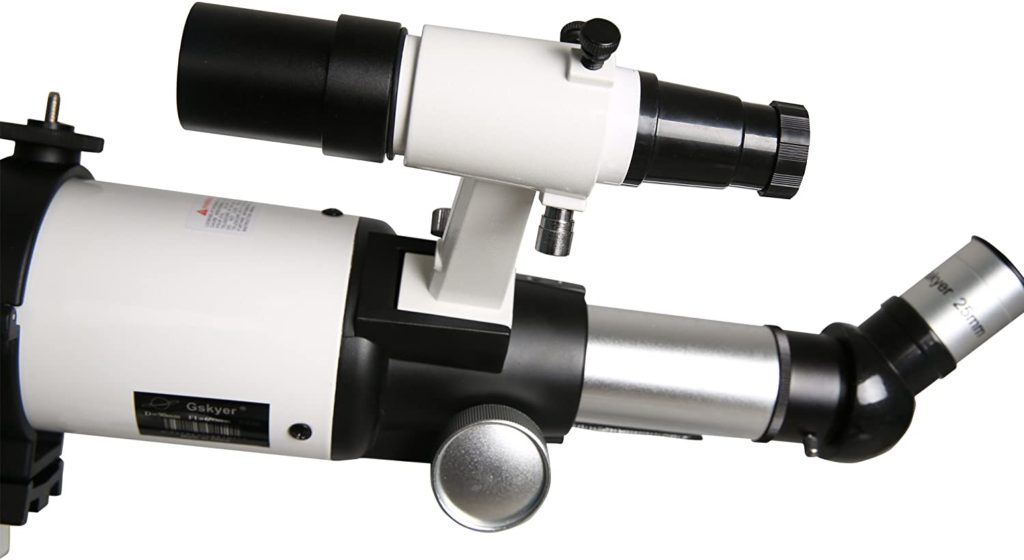
Plus, this model is extremely easy to assemble and doesn’t require any calibration. If you’re a telescope beginner, you won’t have to worry about any tricky steps or complicated tests.
The Gskyer AZ90600 comes with an adjustable tripod. This adjustable aluminium tripod offers the viewer many different viewing positions. The height of the aluminum tripod can be adjusted from about 31.5-inch to 49-inch.
This is one of the best telescopes smartphone astrophotography under 300, it’s 90mm (3.5″) aperture gives bright, sharp images for both land and celestial objects.
Whether you’re viewing the rings of Saturn, the moons of Jupiter, surface details on the Moon, or terrestrial objects, the Infinity 90 Refractor allows the amateur astronomer to explore the solar system and beyond.
Pros:
- Large aperture
- 3 eyepieces
- Smartphone adapter
- Easy to assemble and use
- Adjustable tripod
- Perfect travel telescope
Cons:
- Good for viewing planets, stars not so much
Best For Deep Space Objects (DSOs)
Orion 09007 SpaceProbe
- Type: Reflector
- Aperture: 130 mm(5.1″)
- Focal length: 650mm
- Focal Ratio: f/5
- Mount: Equatorial
- Eyepiece: 25mm, 10mm
- Magnification: 26x, 65x
- Weight: 24.2 lbs.(11 kg)
- Our Rating: 9/10
Prices pulled from the Amazon Product Advertising API on:
Product prices and availability are accurate as of the date/time indicated and are subject to change. Any price and availability information displayed on [relevant Amazon Site(s), as applicable] at the time of purchase will apply to the purchase of this product.
The Orion SpaceProbe 130ST Newtonian Reflector is an excellent and one of the best telescopes for viewing planets, nebulae and other deep sky objects (DSOs). It is well-suited for both beginners as well as intermediate stargazers.
The SpaceProbe 130ST is a 130mm f/5 Newtonian reflector telescope.
This 5.1″ aperture reflector telescope gathers an ample amount of light for great views of the planets and Moon, as well as brighter galaxies, nebulas, and star clusters
The telescope also comes with tools to help you assemble the product, and two eyepieces: 10mm for 65x, and a 25mm for 26x magnification, respectively.
The quick set-up and ease of use makes the SpaceProbe 130ST EQ a very versatile telescope which the whole family can enjoy.
This Orion space probe telescope also boasts a short 24″ long optical tube design which enhances its portability, while the 130mm optical diameter, and the 650mm focal length are in perfect balance with the f/5.0 focal ratio.
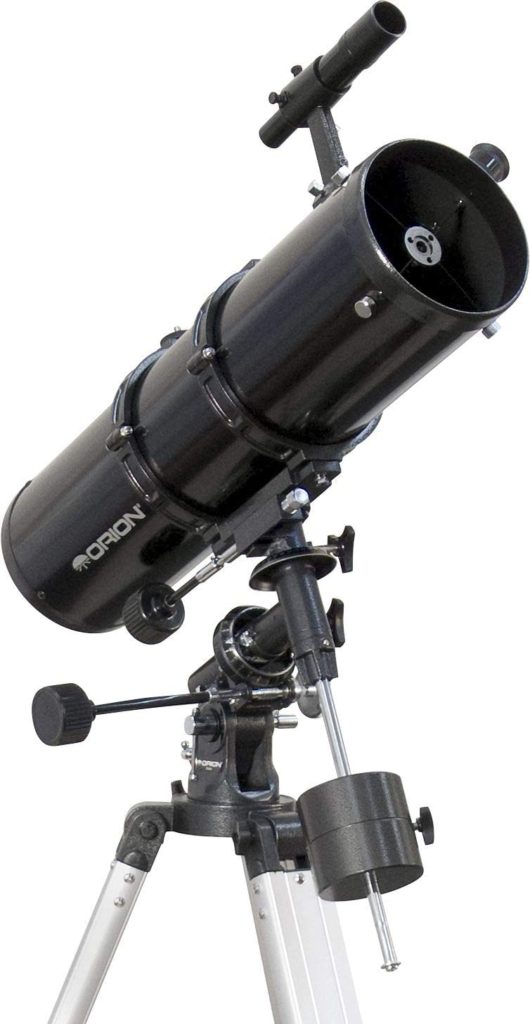
In addition, it possesses design features, such as a parabolic mirror and a specially designed holder for the secondary mirror, that focus the light captured by the aperture and use it to sharpen the images produced by the scope, even with its shorter tube.
The included aluminum tripod is very sturdy, and also includes an accessory tray that can be very useful when you are outdoors in the dark and need a place to organize your accessories neatly.
The equatorial mount is perfectly built and allows manual slow-motion tracking of celestial objects as they move across the sky.
The mount can also be upgraded at a later time to a motorized option that tracks objects automatically, so that’s a nice option to have and definitely a plus if you are using the Orion SpaceProbe 130ST for astrophotography.
Just like many other similar products, the Orion 09007 also comes with Orion’s Starry Night software, which is very useful for beginners, and has the added benefit of alerting the user of upcoming celestial events.
Short 24″ long optical tube design for easy portability and fast f/5 focal ratio for pleasing wide-field performance makes the SpaceProbe 130ST EQ a very versatile telescope the whole family can enjoy
Pros:
- Nice set of accessories
- Can be upgraded to have motorized tracking
- Comes with an Equatorial mount and a versatile tripod
- Easy to assemble and transport
Cons:
- Plastic focuser and mount parts
- Somewhat confusing instructions
Best Telescope Under $300 - Buying Guide
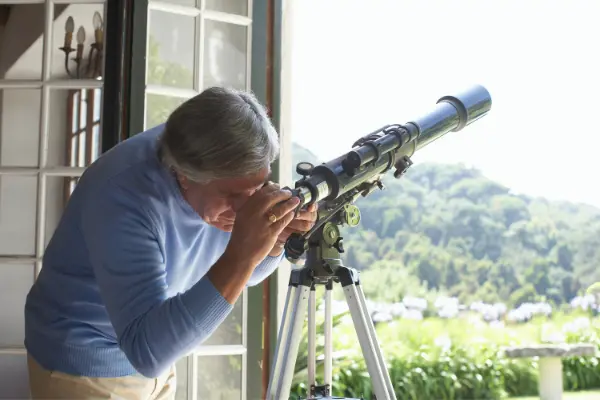
If you’re in the market for a new 300 dollar telescope, you should first know what its main features are all for. The following is a basic guide to the most important characteristics of any telescope.
Features To Consider When Choosing A Good Telescope Under $300
Types Of Telescopes
Refractor Telescope
When most people think of a telescope, the refractor type is what’s going to pop into their minds. This kind of telescope uses a lens to focus light on a single mirror, which is angled to direct the light through an eyepiece into your eye.
The simplicity and reliability of the design makes it easy to use and requires little maintenance. These are excellent for observing objects, planets, the Moon and the galaxies.
Since the optical system is basically a straight line, there are no obstructions from secondary mirrors as there are in Newtonians or catadioptrics.
Reflector Telescope
Reflector telescopes feature a clear piece of glass or plastic at the front of the tube. These don’t warp the light, so they aren’t lenses, but instead a protective shell to keep dust out.
A mirror sits at the back of the tube. It’s curved to focus light on a second mirror, which directs light through the eyepiece and to your eye.
Reflector telescopes are easily identified by the fact that the eyepiece is found near the telescope’s front. These tend to be the least expensive, and you can get larger apertures for a lower price than with other models. The one downside to reflector telescopes is that they must be calibrated regularly in a process called “collimation.”
Compound Telescope (Catadioptrics)
Compound telescopes use an initial lens to focus light onto a mirror at the back of the telescope. The mirror focuses light onto a smaller mirror mounted on the back of the lens, which directs light through a tube that runs through the center of the first mirror and out the back of the telescope.
Compound telescopes are very lightweight relative to other types, and they don’t require collimation like reflector telescopes do.
Aperture
The aperture is always one of the first considerations you need to make when buying a telescope of any kind. Even though it sounds somewhat complex, a telescope’s aperture is basically the diameter of its mirror or lens, depending on whether it’s a reflecting or refracting telescope. The larger the aperture of a telescope, the brighter the images you can view through the lens will be.
Focal Ratio
This represents the speed of the optics. Fast focal ratios (f/3 to f/5) are used for getting a brighter image with a wider field of view and that is why they are used for observing the deep sky. Slower focal ratios (f/6 and above) are better for observing our solar system (the Moon and the planets that surround us) or planets in general, as well as observing binary stars.
Focal Length
The focal length of a telescope has a direct influence on the amount of magnification. Basically, what this means is that the longer the scope’s focal length, the higher its magnification.
Do not assume that the tube length of the scope is its focal length. Complex scopes, despite having short tubes, usually deliver a sharp and clear image. This means that longer focal length is achievable through the proper combination of lenses and mirrors.
Magnification
To get an image suitable for observing with our eyes, a telescope uses a second lens, or collection of lenses, called an eyepiece at the focal plane. The eyepiece magnifies the image from the objective.
The eyepiece also has a focal length. The magnification of a telescope and eyepiece is very simple to calculate. If the focal length of the objective is “F” and the focal length of the eyepiece is “f”, then the magnification of the telescope/eyepiece combination is F/f. For example, if a telescope has an objective lens with focal length of 1200 mm (about 48”) and it has an eyepiece of focal length 25 mm (about 1”), then it will have a magnification of 1200/25=48x.
Eyepieces
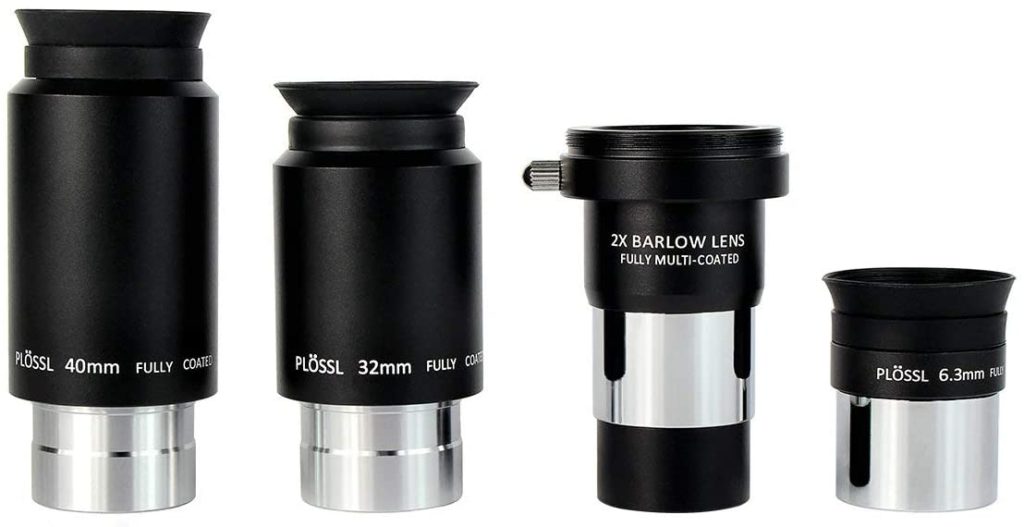
Eyepieces determine the magnification and field of view of a telescope. Different eyepieces are used to view different objects.
Some objects, such as nebulae and star clusters, appear quite large and are best viewed at low magnifications (which give a wider field of view), whereas planets appear very small and are normally viewed with high-magnification eyepieces.
Most telescopes come supplied with one or two eyepieces. Ideally, you’d like to have a set that spans a range of magnifications.
You can expect to spend anywhere from $40 to $250 on a good eyepiece.
A Barlow lens is also worth considering: it multiplies each eyepiece’s power by two or three times, effectively doubling your eyepiece collection.
Mounts
There are 3 common types of mounts available — the altitude-azimuth or “alt-az” mount, the Dobsonian mount, and the equatorial mount. The first one lets you easily move the telescope up and down, as well as clockwise and counterclockwise, whereas the second one’s main function is to reduce stress on the internal components.
Equatorial mounts let you turn the telescope as desired to track celestial objects, making them extremely useful for long-exposure photography; however, they require careful calibration for the same.
Finderscope
A finder scope comes included with a telescope and is normally mounted on the telescope itself.
Each finder scope has either a battery-operated red dot or a set of crosshairs to allow you to align and center an object in its sights.
Aligning the finderscope before viewing through your telescope is an essential step that will help you locate what you’re looking for through the more powerful telescope.
Conclusion
Our first pick for the best telescope under 300 dollars is the Celestron AstroMaster 130EQ. This 130mm f/5 Reflector Telescope features a 650mm focal length and an oversized parabolic mirror that produce detailed images of the Moon, clear views of the planets, and the ability to resolve distant objects such as nebulae and galaxies.
Our next pick for the best telescope under 300 for astrophotography is the Gskyer AZ90600. You will receive a smartphone adapter along with this scope which is great for iphone astrophotography.
We highly recommend Orion 8944 SkyQuest XT6 as your best choice if you are looking for a dobsonian.
The Orion SkyQuest XT6 Classic Dobsonian telescope can open up the night sky for you and your entire family. With excellent light grasp, point-and-view ease of use, convenient portability, and a low price that can’t be beat.
Written by:

Chandrashekhara Rao
I grew up in a rural community with a dark sky, and that is where I learned to appreciate planets and stars at an early age. I have been fascinated with all things astronomical since I was a kid and started with a cheap-and-cheerful 60mm refractor on a wobbly tripod.
ABOUT US
We are a team of active amateur astronomers, here to help you with all your astronomy and science related needs – this is anything, from reviewing the latest telescopes to be released to talking about gravity and neurons. The Big Bang Optics was started because of our love for astronomy and to help others like us find the best telescope and accessories.
LEGAL DISCLAIMER
The Big Bang Optics is a participant in the Amazon Services LLC Associates Program, an affiliate advertising program designed to provide a means for sites to earn advertising fees by advertising and linking to Amazon.com. The Big Bang Optics also participates in affiliate programs with Clickbank and other sites. The Big Bang Optics is compensated for referring traffic and business to these companies.

